07 JUNE 1997 - DIAGNOSIS FOR 07 JUNE 06.00 UTC
by KNMI
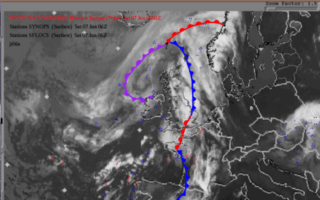
Over the entrance to the English Channel, approximately 49N/05W, an area of enhanced cloudiness is to be seen. In this area a weak Wave in the Cold Front is present (compare Conceptual Models: Wave ). The cloud band of the Cold Front is very distinct in its northern part. Just east of the Cold Front a small surface trough was detected in the isobars.
Within the surface trough and in the Cold Front thunderstorm activity was observed.
Very close to the surface front, approximately 48N/00E, a cloud cluster with cold tops can be detected in which also thunderstorm activity was reported.
For the diagnosis of the physical state of the conceptual model Mesoscale Convective System a couple of key parameter and useful key parameters combinations are available which were chosen with respect to the conceptual model (for more information see Conceptual Models: Cumulonimbus (Cb) and Mesoscale Convective System (MCS) ).
ABSTOP1000 + WA1000-500 + CA 500-300 + IR + Vertical Cross Section
This combination is indicative of growing instability in the troposphere.- The height contours very close to the ground, 1000 hPa (gpm), which in the case of convective clusters often show a trough in front of the Cold Front.
- In the case of convective clusters, advection of warm air in the lower layers causes growing instability.
- Advection of cold air in the upper layers can also be the source of growing instability.
|
07 June 1997/06.00 UTC - Meteosat IR image; cyan: height contours 1000 hPa, red: temperature advection - WA 1000 hPa, blue:temperature advection -
CA 500hPa; position of vertical cross section indicated
|
07 June 1997/06.00 UTC - Vertical cross section; black: isentropes (ThetaE), red thin: temperature advection - CA, red thick: temperature
advection - WA, orange thin: IR pixel values, orange thick: WV pixel values
|
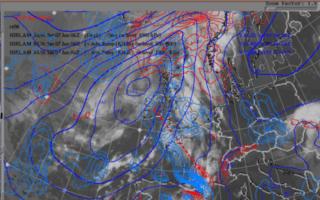
|
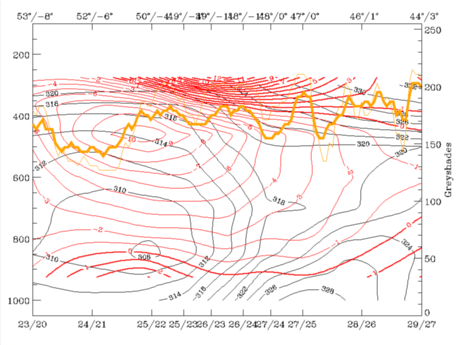
|
Thickness 1000/500/ThetaW 850 hPa + WV + Vertical Cross Section with relative humidity
In the case of mesoscale convective systems the sensitive area is within the thickness ridges and in a very distinct ThetaW 850 hPa ridge with relatively high values. In most of the cases the pattern of the ThetaW ridge shows great similarity with the thickness ridge. In addition the values of ThetaW 850 hPa give an indication of the amount of potential energy and moisture. The water vapour image gives an indication for moist air at higher levels. Dark grey in the WV images indicates dry air in the middle and higher troposphere. This information can be of great importance in cases of potential instability.The cross section indicates the distribution of humidity in the vertical.
|
07 June 1997/06.00 UTC - Meteosat WV image; black: wet bulb temperature 850 hPa; position of vertical cross section indicated
|
07 June 1997/06.00 UTC - Vertical cross section; black: isentropes (ThetaE), blue: relative humidity, orange thin: IR pixel values, orange thick:
WV pixel values
|
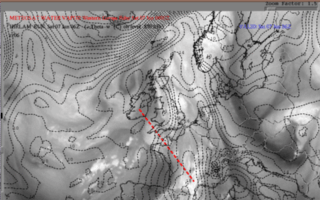
|
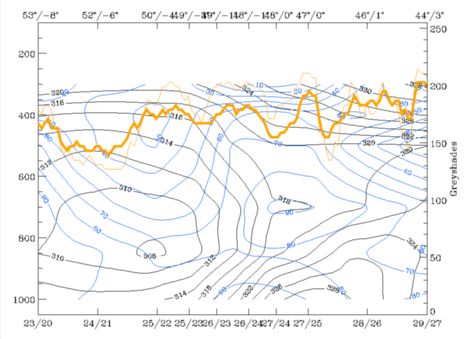
|
In the cross section high humidity values extend to the mid-troposphere within the cloud cluster, but to the north-west and south-east of the cluster the air is moist in the lower levels but relatively dry in the higher parts.
Isotachs 250 hPa >= 60kt + PVA500 >= 2 + IR + Vertical Cross Section
This combination is indicative of dynamical forcing due to the influence of a jet streak.- The isotachs give an indication of the position of the jet streak and the position of the maximum horizontal shear.
- The vertical cross section shows the vertical wind shear which is important for the development of strong Cb clusters.
- PVA500>=2: this parameter shows maxima of positive vorticity advection (PVA) at 500 hPa exceeding 2 units (*10-9sec-2); this key parameter indicates areas with increased vertical motion.
|
07 June 1997/06.00 UTC - Meteosat IR image; black: positive vorticity advection (PVA) 500 hPa, yellow: isotachs 250 hPa; position of vertical
cross section indicated
|
07 June 1997/06.00 UTC - Vertical cross section; black: isentropes (ThetaE), yellow: isotachs, orange thin: IR pixel values, orange thick:
WV pixel values
|
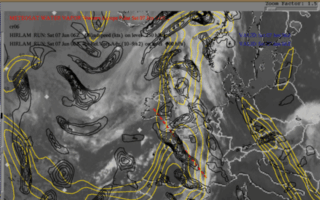
|
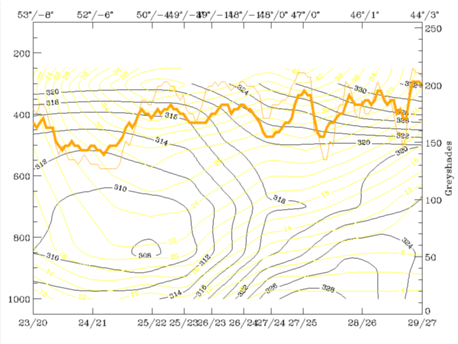
|
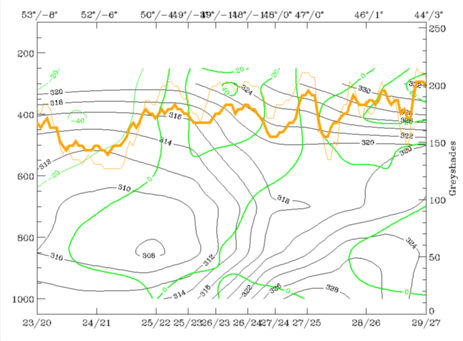
|
|
|
07 June 1997/06.00 UTC - Vertical cross section; black: isentropes (ThetaE), green thick: vorticity advection - PVA, green thin: vorticity
advection - NVA, orange thin: IR pixel values, orange thick: WV pixel values
|
The cross section of the isotachs indicates a positive wind shear in the vertical in the area of the investigated cluster. Positive wind shear is a clear indication that up- and downdrafts in the single Cb cells will be separated. This phenomena will lengthen the life cycle of the Cbs substantially.
Divergence and vertical motion
This combination indicates the role of divergence in the total vertical motion (omega).This combination is best shown with vertical cross sections because the height of the maxima and minima of divergence and omega can vary much from case to case.
- The omega parameter indicates the vertical motion as a result of differential temperature advection, vorticity advection or from diabatic heating.
Divergence indicates the dynamical forcing by PVA or by friction effects.
|
07 June 1997/06.00 UTC - Vertical cross section; black: isentropes (ThetaE), magenta thin: divergence, magenta thick: convergence, orange thin: IR
pixel values, orange thick: WV pixel values
|
07 June 1997/06.00 UTC - Vertical cross section; black: isentropes (ThetaE), cyan thick: vertical motion (omega) - upward motion, cyan thin:
vertical motion (omega) - downward motion, orange thin: IR pixel values, orange thick: WV pixel values
|
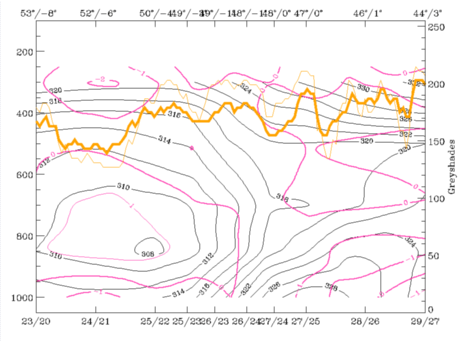
|
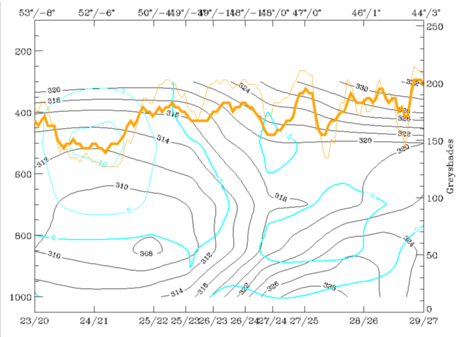
|
Relative streams
This parameter shows relative streams on isentropic surfaces; relative streams are indicative of the different air masses involved in the process and of areas with sinking or rising air; they can be used to interpret cloud configurations requiring special explanation.Although of much importance in a conceptual model of mesoscale convective clusters, the relative streams could not be calculated for this case study and are not further discussed here.
Summary of diagnosis 06.00 UTC
The investigated cloud cluster is within an area where dynamic forcing is present but not significant. Most of the features are situated just west of the cluster, or even east of it.A larger area over France is within very unstable and, in the lower levels, very moist air, which is ideal for the development of thunderstorms. The vertical wind shear in the area of the cluster also play an important roll in the development.
The parameters and the combination of parameters used in this case indicate an ideal situation for the development of a Mesoscale Convective System. However, the area in which these clusters could develop was much larger than the cluster itself. Why the shower activity was enhanced in that particular small area is not clear from the model analysis. The low (for mesoscale developments) resolution of the models, combined with the fact that model analyses are a combination of guesswork and observations, could be the cause of this.

